Keywords
|
| Mobile Ad hoc Network (MANETs), heterogeneous networks, link asymmetry. |
INTRODUCTION
|
| Mobile ad hoc networks (MANETs) plays an important role in present and future communications because of the increasing use of wireless portable devices such as mobiles and laptops. MANETs do not have a fixed infrastructure. It consists of mobile nodes that communicate wirelessly. Nodes that are within each other’s range can discover and communicate directly. However, for communication between nodes that are out of range, intermediate nodes act as routers that forward packets to the destination. MANETs can be heterogeneous in nature, in terms of node characteristics such as transmission power (range), transmission data rate, processing capability, reliability, and security level. Thus nodes may transmit at different power levels, thereby causing communication links of varying range. This causes link asymmetry which leads to several problems such as unidirectional link problem, heterogeneous hidden and exposed problems that severely affects the network performance. |
| In this paper, introduction section is followed by problems due to link asymmetry in section II. Section III an overview of existing works is explained. The problems observed from the literature survey are explained in section IV which is continued by proposed solution and conclusion in section V and VI. |
PROBLEMS DUE TO LINK ASYMMETRY
|
| Various issues due to link asymmetry include: |
| A. Unidirectional link problem. |
| This problem occurs when routers with lower transmission range cannot respond to those having higher transmission range. As shown in Fig. 2, link between router R and client G is a unidirectional link. G cannot send CTS to respond RTS from router R due to the small transmission range of G. This problem leads to incorrect topological information and misbehavior of routing protocols, which commonly assume that the links of the network are bidirectional. |
| B. Heterogeneous hidden problem |
| In Fig. 2, router R becomes a heterogeneous hidden terminal of client B because router R cannot receive CTS from client B. Hence, a collision occurs if router R accesses the channel when client B receives data from client A. |
| C. Heterogeneous exposed problem |
| As shown in Fig. 2, both clients C and D are heterogeneous exposed terminals for router R, because clients B and C remain silent by receiving router R’s CTS. However, the communication between client B and client C will not affect router R to receive data from client F or client E. Obviously, the spatial reuse of network channels significantly decreases, because in this way a number of clients are forced to remain silent unnecessarily. |
AN OVERVIEW OF EXISTING TECHNIQUES
|
| Mahesh K. Marina et.al, 2002 [1] compared routing approach that uses both unidirectional and bidirectional links with routing that uses only bidirectional links to find out if there is any performance improvement by utilizing unidirectional links. They studied the connectivity and path cost metrics when unidirectional links are used, and when they are ignored. To create unidirectional links, they used different transmission ranges. From simulations, they concluded that routing over unidirectional links usually causes high overheads and protocols that avoid unidirectional links perform better. To detect and eliminate unidirectional links, some additional protocol operations are needed. To investigate this issue, they studied the performance of three techniques for AODV; BlackListing, Hello, and ReversePathSearch. BlackListing and Hello techniques eliminate unidirectional links whereas in ReversePathSearch, for a unidirectional link, multiple paths between the nodes are discovered. They compared packet delivery fraction, average delay, and the route search failures of these three methods as a function of the number of unidirectional links. From the simulation results they concluded that ReversePathSearch outperforms all other methods. In fig-3, (a), they comapared Packet delivery ratio for various methods and the graph shows ReversePathSearch is better. Similarly in (b) and (c) they compared Avg. delay and Route search failures which also shows ReversePathSearch as the better one. |
| X. Du et.al, 2006 [2] presented a new routing protocol called multiclass routing, which is specifically designed for heterogeneous MANETs. They also designed a new medium access control (MAC) protocol called hybrid MAC (HMAC) that is more efficient than IEEE 802.11b.In this paper, they have considered two types of nodes. One type has larger transmission power (range), data rate, processing capability etc. than others known as backbone nodes (B-nodes). The less powerful nodes are known as general nodes (G-nodes). The main idea behind multiclass routing is to let most of the data traffic through the more powerful nodes i.e. B-nodes. This is because it provides better reliability and fault tolerance, larger throughput because of higher data rate band less overhead due to lesser number of hops in routing. To achieve this, they divided the entire routing area into cells of equal size. From each cell a B-node was selected and routing was performed based on this. They compared and proved through extensive simulations that MC routing is better than a popular routing protocol-Zone Routing Protocol (ZRP), in terms of different metrics such as overhead, energy consumption, throughput, delay and scalability. For HMAC, they combined time-slotted mechanism with contention-based mechanism. Experimental results show that HMAC provides higher throughput and incurs smaller delay than IEEE 802.11b. In Fig-4 they compared Throughput of MC and ZRP which shows MC is better. Similarly in fig-5, they compared Delay of both methods and here also delay is lesser for MC. |
| S. Yang et.al, 2009[3] presented a cross-layer approach that minimizes problems caused by link asymmetry that simultaneously spans the MAC and network layers for Heterogeneous MANETs. They also consider the advantages of such networks as well. Based on node’s random distribution characteristics, they designed a heterogeneous Location service (HLS) protocol in the network layer. A powerful node’s high capability to achieve low overhead, accurate location information and high robustness were taken into consideration. Second, based on HLS, they proposed a new protocol; Heterogeneous Position based Routing (HPR) protocol. This protocol is adaptive to node densities and rarely generates routing packets. Now to solve the MAC problems, a new Heterogeneous MAC (HMAC) protocol that closely ties in with HPR was designed. Experimental result shows that it works well in networks were density of powerful nodes is low. It also provides low end-to-end delay, control overhead, high packet delivery ratio and robustness. Further they compared this scheme with multiclass (MC) routing and showed that this method performs better. |
| W. Liu et.al, 2009 [4] developed a device–energy–load aware relaying (DELAR) framework to address the issue of energy conservation for heterogeneous ad hoc networks based on cross layering. It includes power-aware routing, transmission scheduling, and power control. Here various energy saving techniques such as power saving modes, transmission power control, power MAC and power-aware routing are integrated to jointly achieve better energy conservation.Similar to X. Du et.al, 2006 [2], here also the nodes are classified as B-nodes, having limited power and P-nodes, having relatively unlimited power supplies. P-nodes are utilized as much as possible and B-nodes as less as possible in order to avoid collisions and minimize interference to other ongoing transmissions. Also, they divided time into time slots of equal length, called Superframes. In each of the superframes, some time periods are exclusively designated to P-nodes, while the rest are shared by all Pnodes and B-nodes in the network. Further, mini-routing and asymmetric MAC (A-MAC) protocols are developed to support the MAC layer acknowledgements over unidirectional. Finally, a multi- packet transmission technique is also presented to further improve the delay performance. However, since this scheme relies on global synchronization of network nodes and assumes that all frames are successfully transmitted, it is hard to deploy. |
| Peng Zhao et.al, 2009 [5] developed a loose-virtual-clustering-based (LVC) routing protocol for power heterogeneous MANETs i.e., LRPH. To detect the unidirectional links, a novel hierarchical structure is maintained. Through clustering a virtual backbone is created. For each cluster, a high power node is selected as the cluster head. Data packet forwarding is avoided through high power nodes. In this way, the channel space utilization and network throughput are largely improved. To evaluate the performance of this scheme, various metrics they used are throughput, packet delivery ratio (PDR), end-to-end delay, normalized overhead, and energy consumption per received packet (ECRP). From simulation results they have proved that this approach achieves much better performance than other existing protocols. |
| To solve problems raised by link asymmetry in mesh access networks working in an ad hoc model Yuefeng Huang et.al, 2009 [6] developed a cross-layer-based approach. They established reverse paths for unidirectional links at the network layer and shared the topological information with the MAC layer. Through channel reservation and handshake mechanisms, they addressed the heterogeneous hidden and heterogeneous exposed problems at the MAC layer. They compared this approach with a few representative protocols and through extended simulations, they proved that this approach is more efficient in terms of throughput and incurs lower cost for WMANs. |
PROBLEM IDENTIFICATION
|
| From the literature survey of current works, it is seen that with high-power nodes, MANETs can improve network scalability, connectivity, and broadcasting robustness. However, the throughput of power heterogeneous MANETs can be severely impacted by high-power nodes. This is due to the large transmission range of high power nodes which leads to large interference, which further reduces the spatial utilization of network channel resources. It also leads to link asymmetry which leads to unidirectional link problem, heterogeneous hidden problem and heterogeneous exposed problem. A number of schemes exist, to address these problems such as Black Listing, Hello, and Reverse Path Search [1] that directly bypass unidirectional links and route packets via bidirectional links, multiclass routing [2] that is specially designed for heterogeneous MANETs, cross layering approaches [3, 6], a loose-virtual-clustering-based (LVC) routing protocol [5] to exploit the benefits of high-power nodes and eliminate unidirectional links. However, they were unsuccessful in considering all these problems simultaneously and at the same time making use of the advantages of high power nodes such as large transmission range. Hence our objective is to take the advantages and avoid the disadvantages of high power nodes and improve the routing performance of power heterogeneous MANETs. |
PROPOSED SOLUTION
|
| The three problems raised by link asymmetry, is related to the network layer and the link layer. If the MAC protocol can obtain the topology information from the network layer for routing, and the routing protocol can make use of the MAC protocol to directly address the unidirectional link problem, network performance can be largely improved. For this we adopt cross layering between network layer and link layer [6]. Reverse paths are established for unidirectional links. To address heterogeneous hidden terminal problem, the transmission of router is delayed on demand. To prevent heterogeneous exposed terminal problem, the coverage of the CTS frame can be decreased. To reduce the interference caused by high power nodes, we propose a loose-virtual-clustering (LVC) based algorithm [5]. Here, through clustering a virtual backbone is created. For each cluster, a high power node is selected as cluster head. Low power nodes under the coverage of these high power nodes will form a cluster. High power nodes are used to broadcast only the local information to neighbouring nodes and forward broadcasting RREQ packet.Low power nodes are used to forward the data packets. |
CONCLUSION
|
| MANETs are likely to consist of devices with varying capabilities. Nodes are likely to transmit at different power levels, thereby causing communication links of varying range. This causes link asymmetry which leads to unidirectional link problem, heterogeneous hidden and exposed problems as well as interference from high power nodes. All these can adversely affect the network performance. To solve the problems caused by link asymmetry a cross layer approach [6] is proposed and to reduce interference LVC routing protocol [5] is suggested. |
Figures at a glance
|
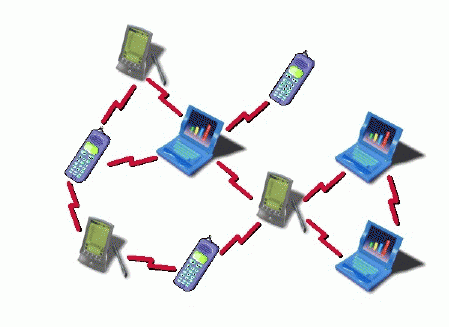 |
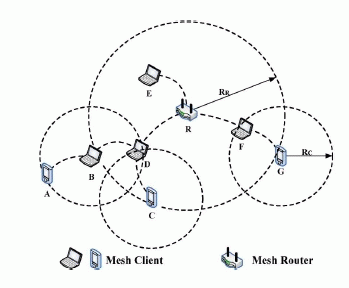 |
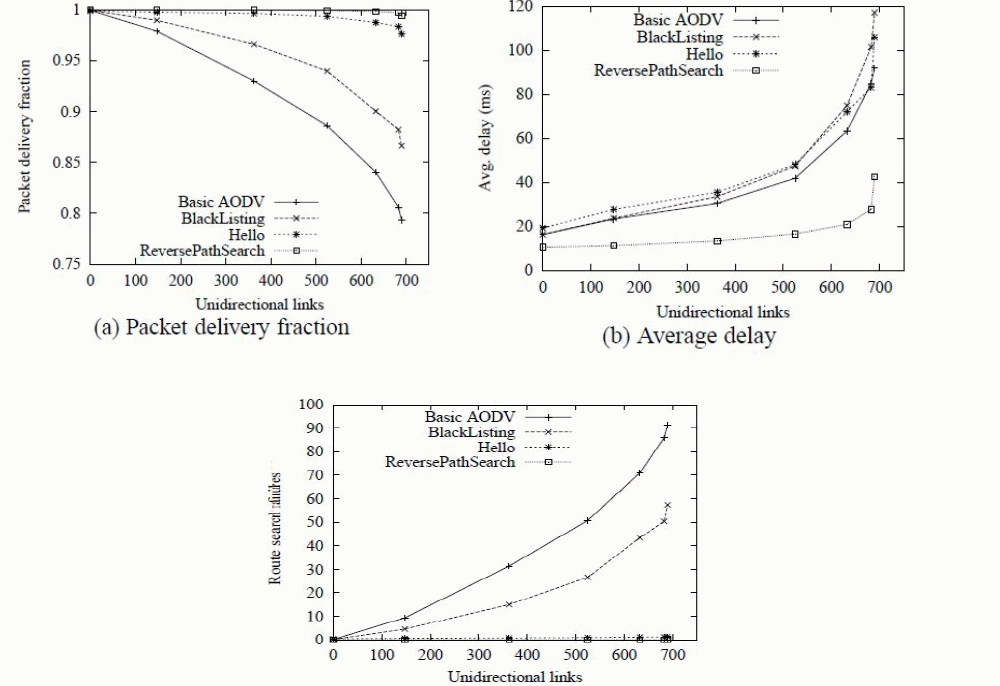 |
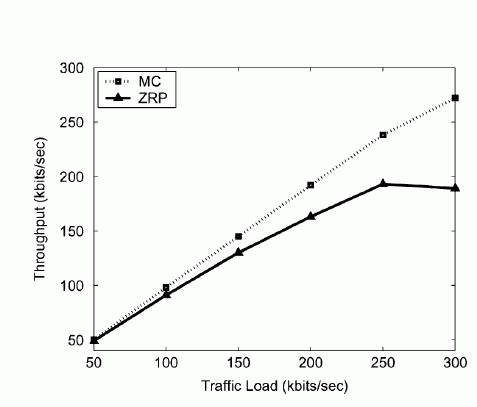 |
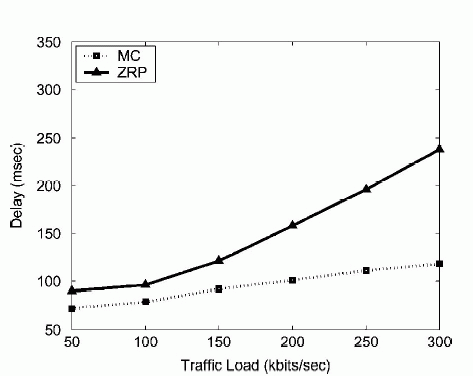 |
| Figure 1 |
Figure 2 |
Figure 3 |
Figure 4 |
Figure 5 |
|
| |
References
|
- M. K. Marina and S. R. Das, “Routing performance in the presence of unidirectional links in multihop wireless networks,” in Proc. ACM MobiHoc, Lausanne, Switzerland, pp. 12–23, Jun. 2002.
- X. Du, D. Wu, W. Liu, and Y. Fang, “Multiclass routing and medium access control for heterogeneous mobile ad hoc networks,” IEEE Trans. Veh. Technol., vol. 55, no. 1, pp. 270–277, Jan. 2006.
- S.Yang, X.Yang, and H.Yang, “A cross-layer framework for position based routing and medium access control in heterogeneous mobile adhoc networks,” Telecommun. Syst., vol. 42, no. 1/2, pp. 29–46, Oct. 2009.
- Wei Liu; Chi Zhang; Guoliang Yao; Yuguang Fang, “Delar: A deviceenergy-load aware relaying framework for heterogeneous mobile adhoc networks eous networks,” IEEE Journal on Selected Areas in Communications, vol. 29, no. 8, pp. 1572–1584, September 2011.
- Peng Zhao, Xinyu Yang, Wei Yu, and Xinwen Fu, “A Loose-Virtual-Clustering based Routing for Power Heterogeneous MANETs,” IEEEtransactions on vehicular technology, vol. 62, no. 5, June 2013.
- Y. Huang, X. Yang, S. Yang, W. Yu, and X. Fu, “A cross-layer approach handling link asymmetry for wireless mesh access networks,” IEEE Trans. Veh. Technol., vol. 60, no. 3, pp. 1045–1058, Mar. 2011.
- A. Jeng and R.-H.Jan, “Adaptive topology control for mobile ad hoc networks,” IEEE Trans. Parallel Distrib. Syst., vol. 22, no. 12, pp. 1953– 1960, Dec. 2011.
- C. H. Yeh, “The heterogeneous hidden/exposed terminal problem for power-controlled ad hoc MAC protocols and its solutions,” in Proc.IEEE 59th VTC, pp. 2548–2554, May 2004.
- Jie Wu and Fai Dai, “Virtual backbone construction in manets using adjustable transmission ranges,” IEEE Transactions on MobileComputing, vol. 5, no. 9, pp. 1188–1200, Sep. 2006.
- N. Poojary, S. V. Krishnamurthy, and S. Dao, “Medium access control in a network of ad hoc mobile nodes with heterogeneous powercapabilities,” in Proc. IEEE ICC, Helsinki, Finland, pp. 872–877, Jun. 2001.
- V. Shah, E. Gelal, and P. Krishnamurthy, “Handling asymmetry in power heterogeneous ad hoc networks,” J. Comput. Netw.—Int. J.Comput.Telecommun.Netw., vol. 51, no. 10, pp. 2594–2615, Jul. 2007.
- V. Shah, S. Krishnamurthy, and N. Poojary, “Improving the MAC layer performance in ad hoc networks of nodes with heterogeneous transmit power capabilities,” in Proc. IEEE ICC, pp. 3874–3880, Jun. 2004.
- Y. Y. Su, S. F. Hwang, and C. R. Dow, “An efficient cluster-based routing algorithm in ad hoc networks with unidirectional links,” J. Inf. Sci. Eng., vol. 24, no. 5, pp. 1409–1428, 2008.
- http://www.google.co.in/imgres?sa=X&biw=1366&bih=587&tbm=isch&tbnid=pby2PdR7ctOpM:&imgrefurl=http://harishkumarhn.50webs.com/research.html&docid=FK7CIm6qqsAT5M&imgurl=http://harishkumarhn.50webs.com/images/MANET.gif&w=541&h=385&ei=JEPrUo fwHsTqrAe6moHICQ&zoom=1
|